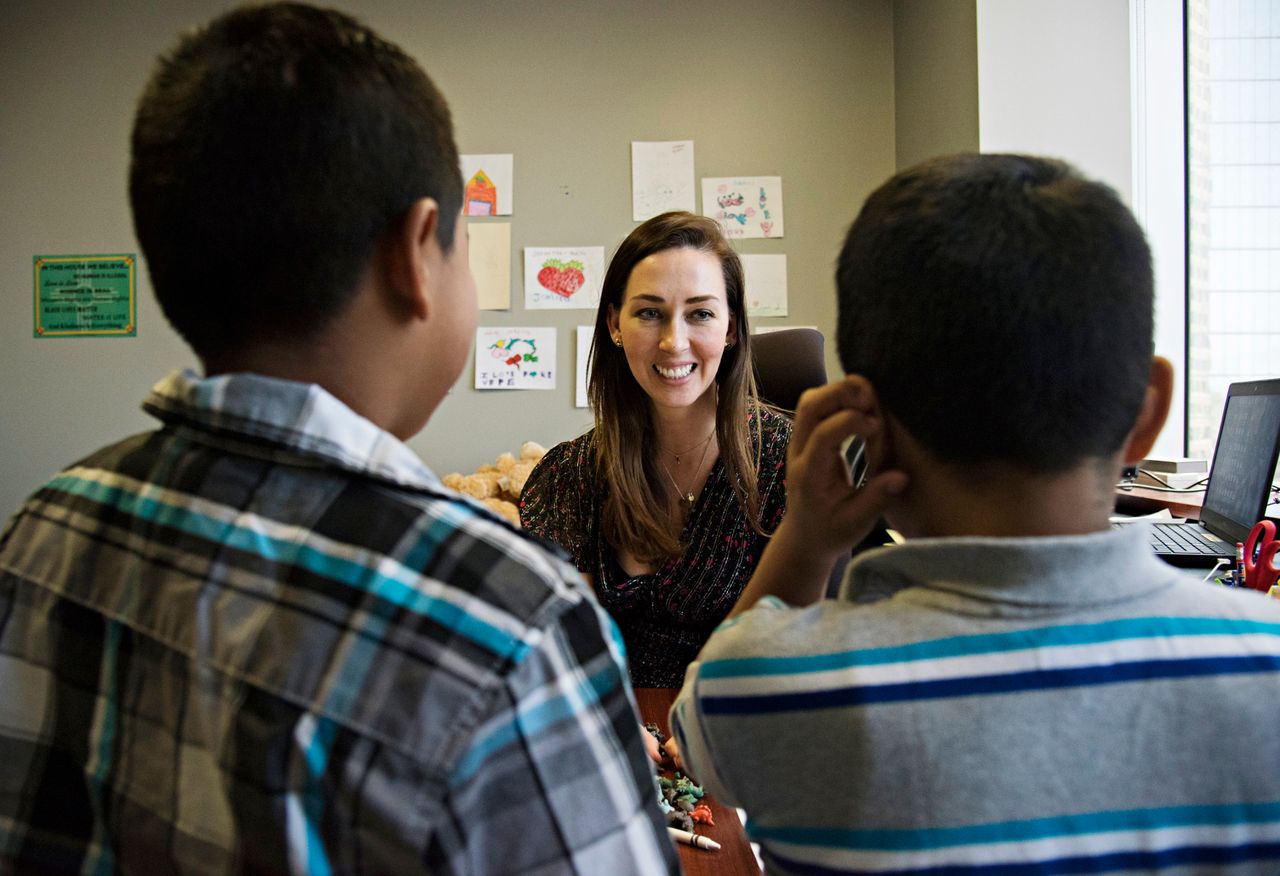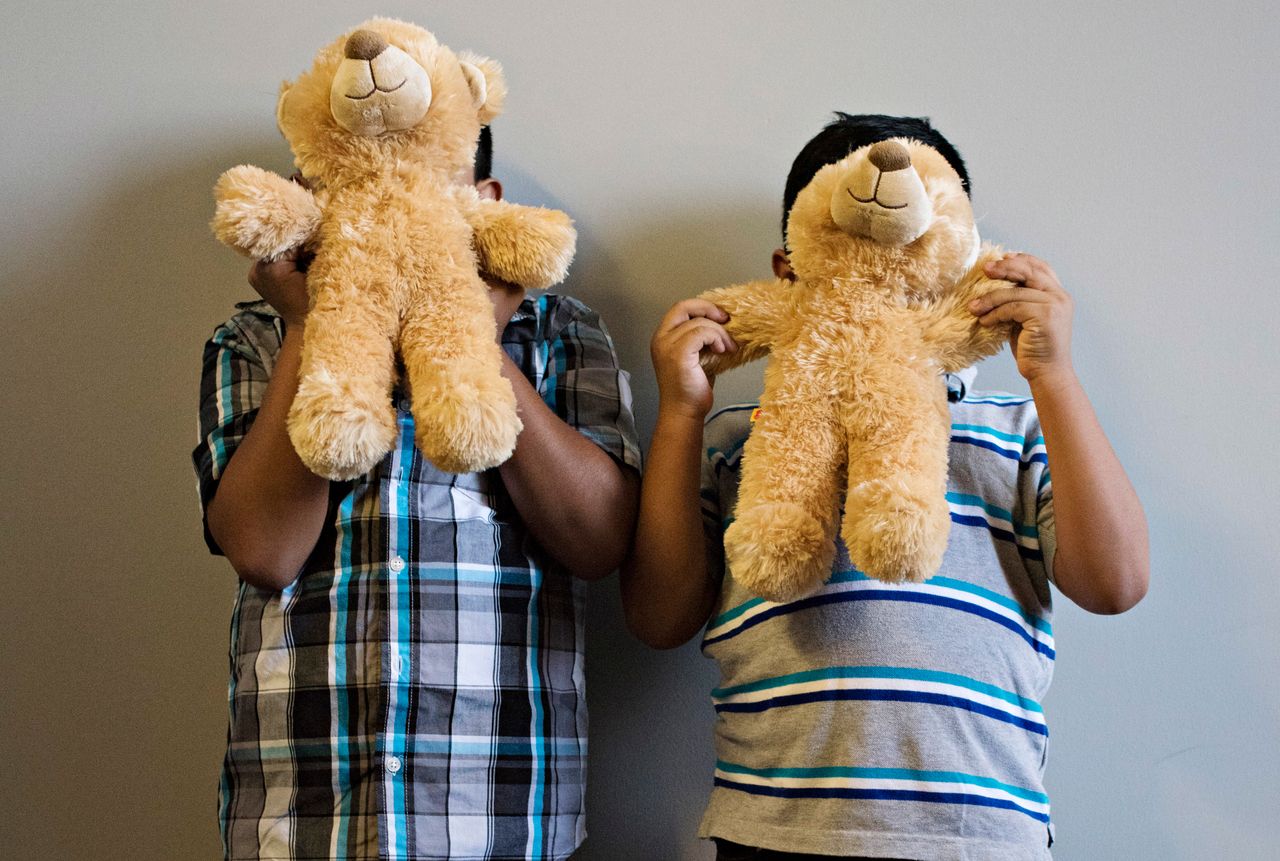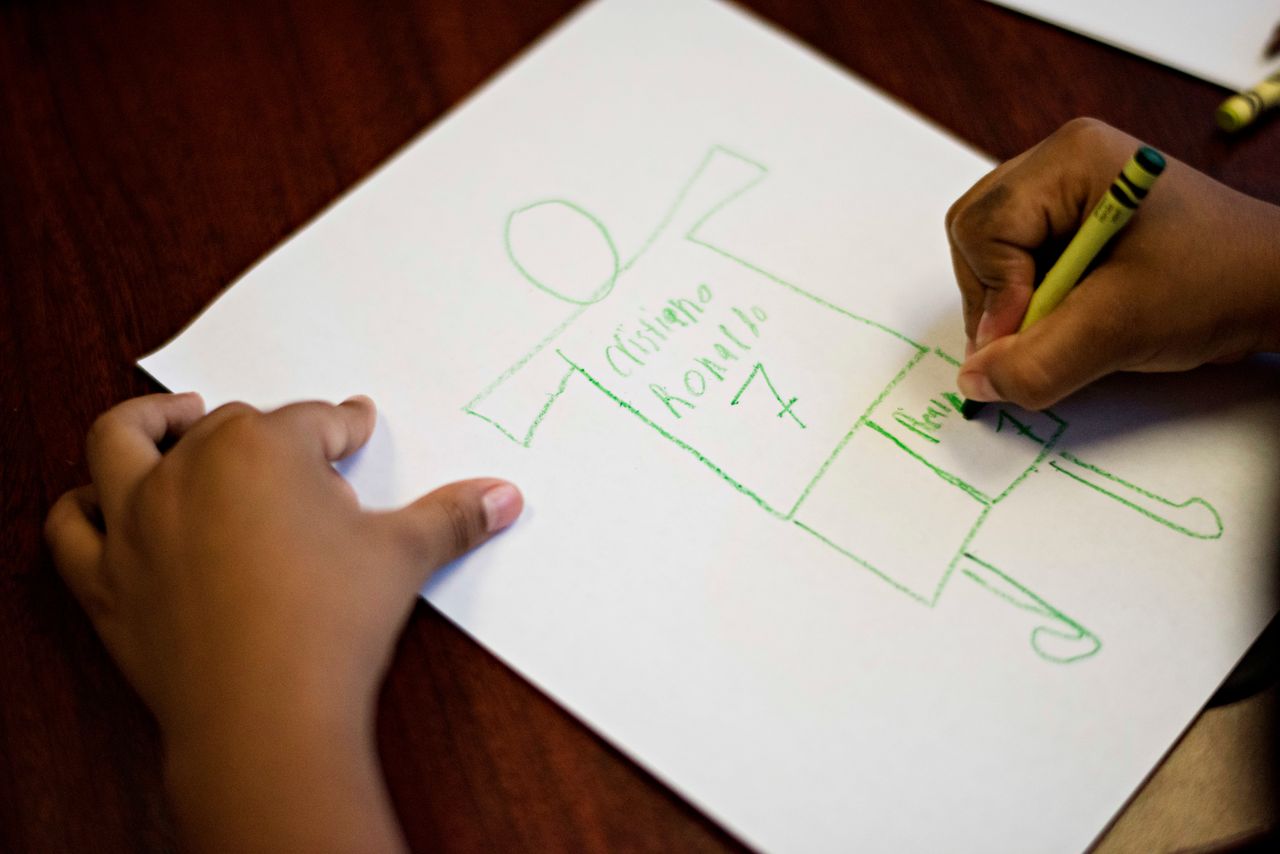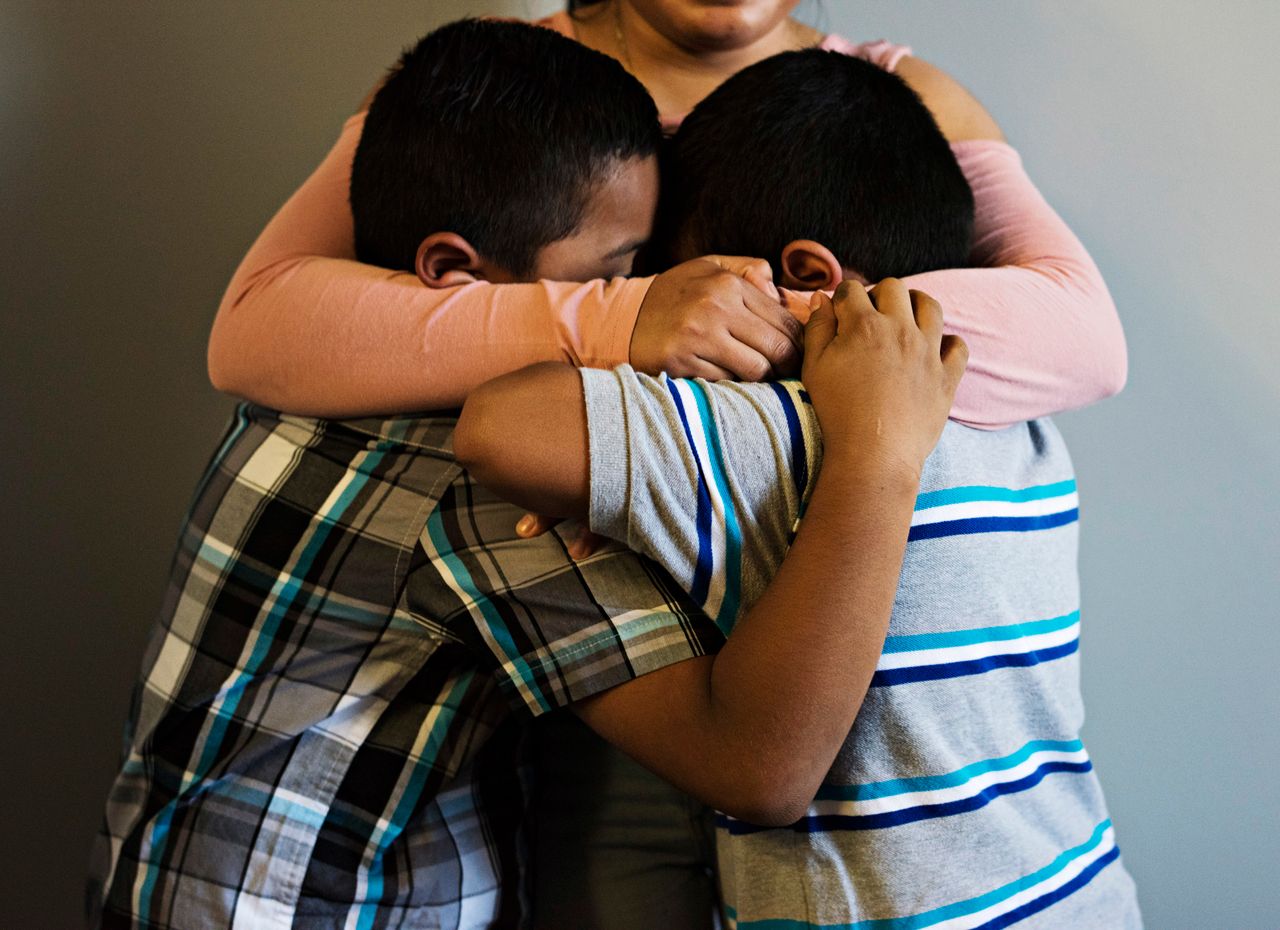LOS ANGELES – In 2016, Luis sat in his lawyer’s office and drew a black, snake-like object, surrounded by sad faces. “My dad hit me with a cable from the television,” the 4-year-old told Joanna Fluckey, an attorney at Kids In Need Of Defense (KIND). His 7-year-old brother, Jorge, drew a boxy figure throwing a rock through a window. “I don’t like living with dad because he hit us,” he explained to his lawyer. “When we lived with mom and dad, my dad broke a window because he hit my mom.”
Luis and Jorge, whose last names HuffPost has omitted to protect their identities, were unable to articulate their trauma before Fluckey gave them crayons. When she asked questions about their life in Guatemala, they would become quiet, look toward the ground and sometimes cry. “There were a lot of tears at first,” said Fluckey. “They were just kind of shut down around other humans.”
Jorge says it was terrifying to have an adult he barely knew interrogate his childhood abuse. “I was scared because I had to tell her a lot of things from my dad,” he said while sitting on a brown couch in the waiting room of Fluckey’s downtown office last Wednesday while clutching an electronic toy called a Leap Pad. “I didn’t know her.”
In the coming months and years, many children who recently crossed the border will have to go through the traumatizing process of talking about their violent past in front of legal experts, judges and asylum officers. In the majority of cases, they will not have an attorney or parent by their side for support.
The U.S. immigration system was already daunting for migrant children before the Trump administration announced its zero tolerance policy on illegal entry into the country. Now, because more than 400 parents have been separated from their kids after crossing the border and deported, children who never expected to be on their own will have to navigate a complicated legal system without any parental support. (This week, the government tried to dodge its responsibility to locate the hundreds of parents who were deported without their kids under the zero tolerance policy.)
Toddlers have already had to appear in immigration court without their parents. Legal experts worry about how children still not old enough to tie their shoes will be further traumatized by having to tell their horrific stories over and over again throughout the immigration process.
“The legal system is not designed for children,” said Julie Linton, a pediatrician who works with immigrant children. “I can only imagine how confusing it [is for] a young child who doesn’t speak English, who had limited access to education and who is not from the U.S., to be thrown into a system that is designed for adults.”

By the time a child speaks to a lawyer or appears in immigration court, they have already experienced multiple levels of trauma. Most migrants are fleeing gang violence or domestic violence in Central America, and after a harrowing journey to cross the border, are temporarily held in freezing cold Border Patrol stations where many have been physically and verbally abused by guards.
After being put in government-run shelters, kids must appear in court to state whether or not they’ll be applying for immigration relief. If the judge grants them a continuance, they begin a process that can last up to a few years and that involves telling and re-telling their story to lawyers, judges and asylum officers.
During asylum interviews, officers ask kids very detailed questions over the course of a few hours about the lives they fled.
“It can be very traumatizing for children to have to share their story in a way that is so descriptive of what happened,” said Linton. “They essentially have to re-live that experience each time they have to share that narrative.”
Brothers On The Run
Jorge and Luis, now 9 and 6, both have short black hair that frames their chubby cheeks and bright eyes. They like to dress the same – on a recent visit to Fluckey’s office they wore collared shirts with blue, white and grey stripes – and they hold hands while crossing the street. They are happy kids who excitedly played with toys trains, and say their favorite part about school is playing soccer.
Jorge is the chatty one of the pair, but his demeanor deflates when he talks about life in Guatemala. “Our dad hit us when he was mad,” he said in a small voice while fiddling with a toy on his lap. “He goes to go eat with his friends and he leave us with my tía [aunt] Maylin in the house. When he comes to the house he just comes to scream at tía because we were behaving bad.”
Jorge says that every time an adult asked him about his life in Guatemala, he “would get a little sad.” “It’s hard to forget about that,” he said.
The boys’ father is an alcoholic who physically abused their mother so badly that she fled Guatemala in 2013. Once she left for the U.S., he turned his anger toward Jorge and Luis, who were being cared for by Maylin. Their father often woke the kids up in the middle of the night to punch them with closed fits or hit them with television cables and belts. He also verbally and physically abused their aunt.
The situation became so dangerous that their aunt planned an escape. They first fled to Jorge and Luis’ grandparents’ place, but when their father made death threats and got his friends to shoot at the house, Maylin took more drastic measures. In 2015, she and the boys embarked on a 13-day journey to cross the border, which required them to spend some nights walking through the dark and to sleep in small huts and cars.

A Psychological Toll
Child experts say that the lawyers and immigration officials who ask children about their horrific pasts are often not trained to speak with kids about trauma.
Cristina Muñiz de la Peña, the mental health director at Terra Firma, a program that aids immigrant children, said that asking kids about traumatic memories in a non-therapeutic context is like “opening an infected wound without cleaning it,” and can trigger PTSD symptoms such as intrusive thoughts, mistrust and hypervigilance.
The most important thing, according to Muñiz, is to create a trusting and safe environment for kids before asking them difficult questions. For example, Gui Stampur, the deputy executive director of the Safe Passage Project, often kicks around a soccer ball with young children to help them open up.
The KIND office is filled with bins of toys, and Jorge says a teddy bear helped him get through hard conversations during his asylum process. “You’re not scared because you’re holding something,” he said. “It relaxes you.”
A courtroom, by contrast, is a “cold environment that’s very inhumane,” said Muñiz. “When I go to testify [as an expert] my body is tense,” she said. “And I’m a professional with nothing to lose.”
Jennifer Nagda, the policy director for the Young Center for Immigrant Children’s Rights, says immigration proceedings are “adversarial” towards kids and do not take a child’s best interests into account. She describes how a child sits at one table and a government attorney, who is trying to deport them, sits at another. “The whole construct is really challenging for children,” Nagda said. “The child is opposed to the government and carries the burden to prove their right to appear in the U.S.”

Jorge and Luis had never been to a courtroom before their first immigration hearing in May 2016. When the brothers’ names were called, Luis hugged his mom’s neck tightly as she carried him to the front of the room, and Jorge clasped his lawyer’s hand. They were scared of being deported.
Jorge sat down in a leather chair that engulfed his small body and left his feet dangling above the ground. The judge sat so high up that he remembers having to lift his chin toward the ceiling just to see her. She spoke English, and even though there was a translator, Jorge was nervous. “We have somebody in front of us and we need to talk,” he said. “But we are scared to talk.” Fluckey remembers him giving a one-word answer or two into the microphone, but luckily she could tell the judge herself that the boys would be applying for asylum. Stampur said the many children without attorneys face an even more difficult experience in court. “A 7-year-old whose feet don’t touch the ground ... cannot articulate their asylum or visa claim,” he said. “They are only being traumatized further by not ... having someone speak for them.”
Though an asylum office is less intimidating than a courtroom, the experience can be even more nerve-wracking. “The child understands this is a place where someone is going to make a decision about what happens for the rest of their life,” Nagda said. “The child is really on their own to tell their story.”
She said the question and answer format of asylum interviews isn’t conducive to the more narrative way most children tell stories, and that if they make inconsistent statements ― a normal thing for any kid to do ― they could be ineligible for relief. “Formal proceedings don’t lend themselves to adapting to every child’s style,” Nagda said. “And I think as a result, you run the risk of a child not being able to share their story in a full and complete way.”
During Jorge’s asylum interview in July 2016, Fluckey said an officer asked him detailed questions for over an hour about his father’s abuse: “Did your dad hurt you? How did he hit you? Were there any bruises? How long did the bruises last?” He clutched a teddy bear and gave mostly one-word answers while looking at the ground, and Fluckey showed the officer his crayon drawings to help fill in details the 7-year-old struggled to talk about with a stranger. Jorge simply remembers that the officer “asked me a lot of things” and that the bear helped him feel calm.
The experience was even more traumatic for Luis, who was only 4 years old at the time. Fluckey says he cried for the entire hour while sitting on his mother’s lap and saying, “Mommy I want to go home” and “I’m tired.” “He was a little more scary than me,” Jorge remembered. “He didn’t know how to speak ― that’s why it makes it more scary.”
Yet the officer still asked Luis standardized questions that made no sense for a kid of his age. “He’s asking my 4-year-old if he’s ever aided or abetted in a national terrorist organization,” said Fluckey. “And those he’s just required to ask.”
The Trauma Of Family Separation
It’s difficult for any child to talk about horrific experiences with lawyers and immigration officials, but experts worry these interviews will be even harder for the children who were ripped apart from their parents.
Jodi Ziesemer, a supervising attorney at Catholic Charities, said separated children have been crying inconsolably in meetings with their lawyers. “They are so traumatized and upset and want to know where their parent is and why this is happening to them,” she said. “It’s hard to have a conversation with them.” But she adds that since more than 400 parents have been recently deported without their kids, “barely verbal” children now have to make big decisions about their future.
To develop an asylum claim kids have to answer questions such as, “‘Have you ever been harmed or mistreated in your country? Do you fear persecution and by whom? And can you articulate how a government actor has acquiesced in this persecution?’” Ziesemer said. “And we can’t develop that case with a 5-year-old.”
Ideally, Muñiz thinks that medical and mental health professionals should be asking kids about the situations they fled back home and that those statements should be compiled into affidavits to share with immigration officials in lieu of court appearances and interviews. But due to a lack of legal status, many children don’t even have access to mental health services as they go through immigration proceedings, Fluckey said.

Last Wednesday, Jorge and Luis sat once again at Fluckey’s mahogany desk drawing pictures. But this time, instead of sketching their traumatic childhood, Jorge drew a boxy figure in green crayon with the words “Cristiano Ronaldo 7” on the chest, while Luis used a red crayon to write “L. Messi 10” under a smiling face. “They were drawing sadness,” said their aunt Maylin. “But they don’t draw like that anymore.”
After more than two years of living in America, they seem happy. Jorge, who is almost perfectly fluent in English, said he likes the U.S. “because it’s huge.” “My life change because my mom supports me,” he said, while playing with a Rubix cube and sitting beside a teddy bear. “If I behave bad she says ‘Stop’ and ‘Go to sleep or play.’”
But at times, the boys are still haunted by the trauma of fleeing Guatemala and re-living that experience throughout the immigration process. Maylin says that when Luis thinks about the abuse they endured back home, he “cries a lot.” When he saw on TV that immigration officials were separating families, she says he burst into tears. “I didn’t want them to separate my brother,” he explained.
Jorge, who is about to enter third grade, was so affected by appearing in court and in front of an asylum officer that he now wants to be a judge. He knows first-hand how terrifying the process can be for small children, and said he wants to help “save families” like his own by sitting at the podium.
